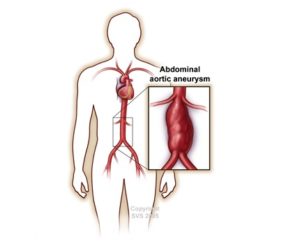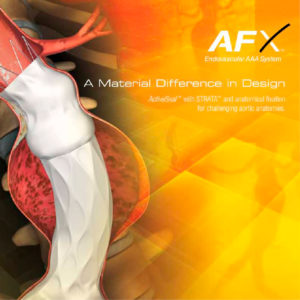What is an Abdominal Aortic Aneurysm (also referred to as AAA)?
 When the wall of a blood vessel weakens, a balloon-like dilation called an aneurysm develops. This happens most often in the abdominal aorta, the bodies largest blood vessel that supplies blood flow to your legs. This condition is fairly common with an estimated 200,000 people being diagnosed with AAA every year in the United States. Untreated, this can lead to a rupture of the dilation which is a medical emergency. A ruptured AAA is the 15th leading cause of death in the country, and the 10th leading cause of death among men older than 55.
When the wall of a blood vessel weakens, a balloon-like dilation called an aneurysm develops. This happens most often in the abdominal aorta, the bodies largest blood vessel that supplies blood flow to your legs. This condition is fairly common with an estimated 200,000 people being diagnosed with AAA every year in the United States. Untreated, this can lead to a rupture of the dilation which is a medical emergency. A ruptured AAA is the 15th leading cause of death in the country, and the 10th leading cause of death among men older than 55.
Aneurysms run in families. If a first-degree relative has had an AAA, you are 12 times more like to develop an AAA yourself. Of patients in treatment to repair a AAA, 15-25% have a first-degree relative with the same type of aneurysm.
What are the symptoms of AAA?
Often there are no symptoms you have an AAA. Most are incidental findings when undergoing testing for another condition. Some people have experienced a pulsing sensation in the abdomen, severe unexplained back pain or pain/discoloration in the feet. It is important to discuss your family history and any symptoms you may be experiencing with your healthcare provider.
How is an AAA treated?

How an AAA is repaired depends on the size of the aneurysm, its location, how fast it is growing, how complicated it is to repair and your overall health. Endovascular repair is the preferred treatment for many people with an abdominal aortic aneurysm. The standard repair for an aneurysm located below the arteries to the kidney consists of the following:
- Through a needle puncture or small incision in one or both of your groin arteries and guided by X-ray images, a thin tube (catheter) is inserted and advanced to the aneurysm site.
- A guide wire and an expandable stent graft (a fabric-covered wire frame) are advanced through the thin tube.
- When positioned correctly, the stent graft is allowed to expand within the artery. The wire frame pushes against the healthy portion of the aorta to seal the device in place.
- Once in place, blood flows through the stent graft and cannot enter the aneurysm.
- Some patients may also require a puncture or small incision into an artery in the upper arm.
- The procedure usually takes 1.5–2.5 hours and most patients leave the hospital in 1–5 days.

